MYTHLOGIC Pollux 1400: Clevo's W150HR Tested
by Jarred Walton on August 23, 2011 12:00 AM ESTI7 Quad-Core + SSD FTW
Starting with our application results, we should see some amazing results. We know Sandy Bridge quad-core chips are fast, and the i7-2720QM is a moderate step up from the entry level i7-2630QM. Combine that with Intel’s 510 SSD—even in 120GB form—and you have a very speedy system. The POST time of 7 seconds on the W150HR could be better, but once Windows 7 starts loading it takes all of 15 seconds to hit the desktop (or 10 seconds to resume from hibernate). With NVIDIA’s Optimus, you also have full access to Intel’s Quick Sync technology while still being able to run graphically intensive games.
That last point brings us to an interesting topic. We’ve noted in the past that PCMark 7 appears to use Intel’s Quick Sync for some tests, and it seriously boosts the result in the Creativity and Computation suites. By default, however, NVIDIA’s Optimus Technology recognizes PCMark 7 and runs it on the dGPU, which results in potentially lower performance. To get around this, we ran PCMark 7 in two modes: once on the GT 555M dGPU and once on the HD 3000 IGP. The overall score isn’t affected that much, but you can see how much it helps in the Creativity and Computation suites.
If you’re wondering what exactly is involved in the various PCMark 7 suites, we recommend looking at the whitepaper. The overall workload is generally lightweight, aiming to simulate a “real-world” experience. To that end, the use of an SSD can have a major impact on performance. Dustin and I feel the benchmark skews too heavily toward SSDs, but Anand feels it’s a better representation of the real world—after all, an SSD will usually be a couple of orders of magnitude faster than an HDD. Then again, that’s only in purely random workloads, sustained for a lengthy period of time, which is why I tend to feel an SSD should be more like a ~25% increase in overall “usefulness” for a PC. With that out of the way, here are the results for PCMark 7. I can’t say the benchmark is perfect, but coming up with something that is certifiably better in all ways is very difficult, which is why we use the results along with testing things like x264 encoding performance.
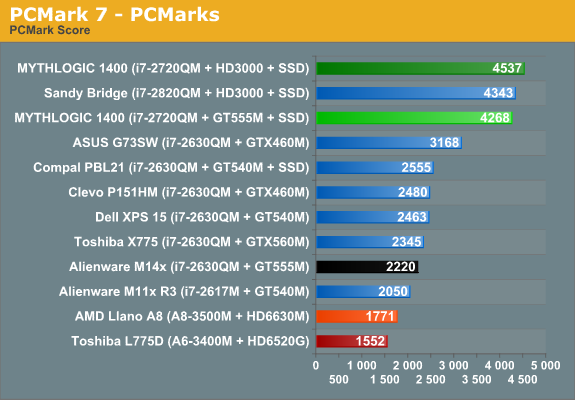
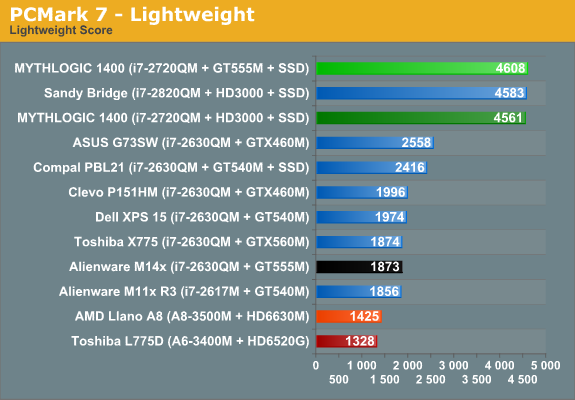

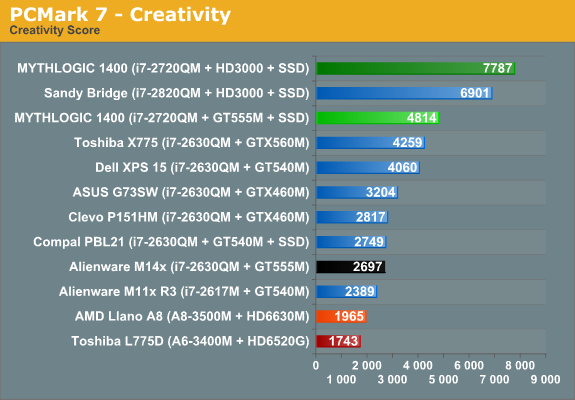

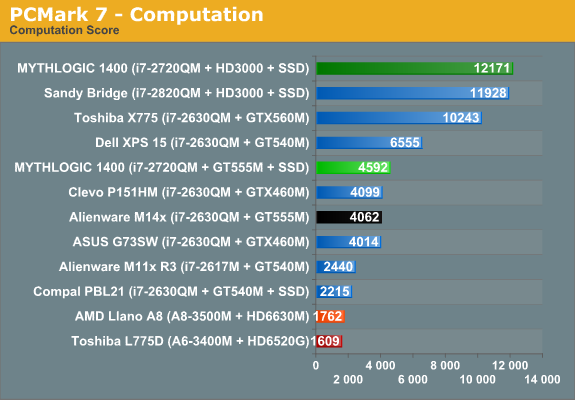
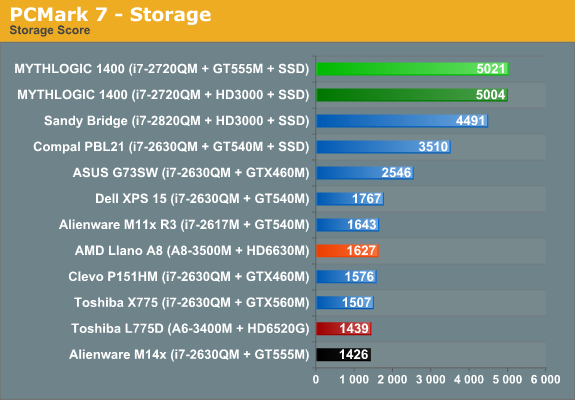
As expected, the MYTHLOGIC Pollux 1400 puts in a great showing. Most of the tests end up slightly faster running on the dGPU, but the Creativity score (which does some video transcoding) is boosted 62% running on the IGP, and the Computation test (which includes video downscaling and a high quality transcode) is 165% faster with the IGP. Those gains might seem unreasonable if you haven’t used Quick Sync; our earlier testing showed that transcoding an HD video with Quick Sync could be done over three times faster than on the CPU, and nearly twice as fast as with a GTX 460M. Throw in an SSD, and nearly every suite shows dramatically improved performance, but that’s because every suite (except for Computation) includes a storage element. As such, the results seen here are absolutely valid, provided you understand what is being tested. If you never transcode videos, the “Computation” suite doesn’t mean much, and if you’re not hitting your HDD/SSD a lot (e.g. just surfing the web), an SSD likely won’t double your pleasure, fun, or anything else. That’s why we again refer you to the PCMark 7 whitepaper.
PCMark Vantage echoes the results of PCMark 7, which is understandable if you look at the PCMark Vantage whitepaper (many of the tests are similar to PCM7 in nature, only without Quick Sync support). The remaining tests focus almost exclusively on the CPU.
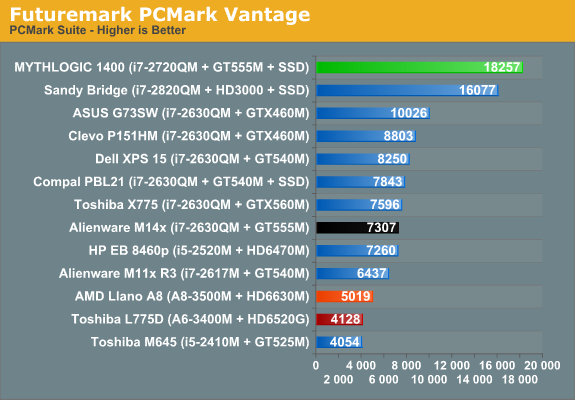
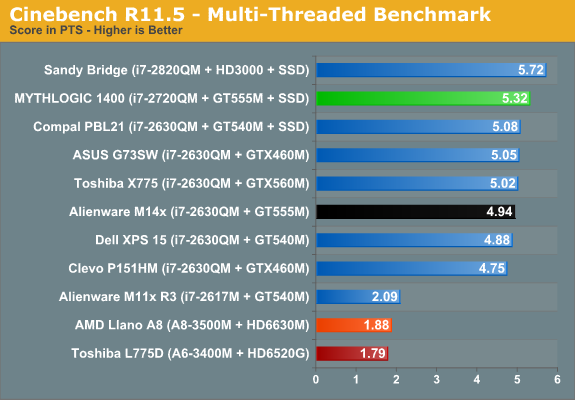
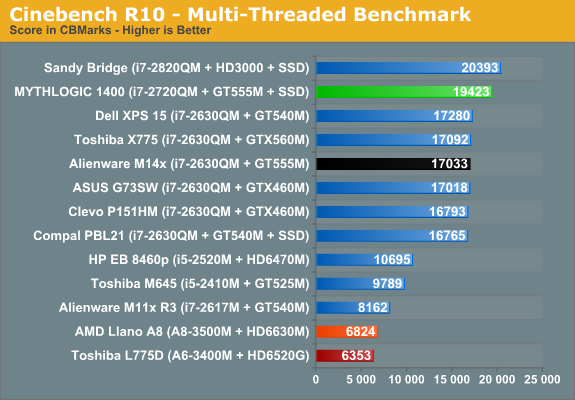
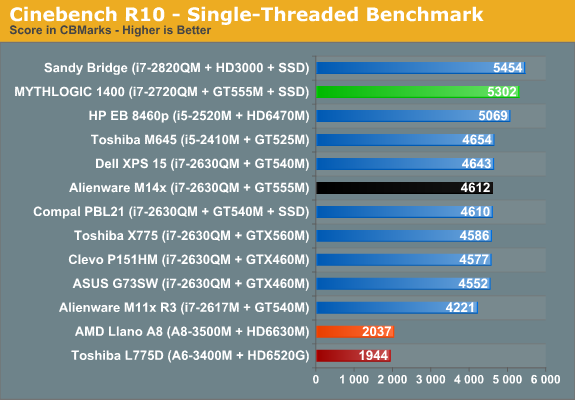
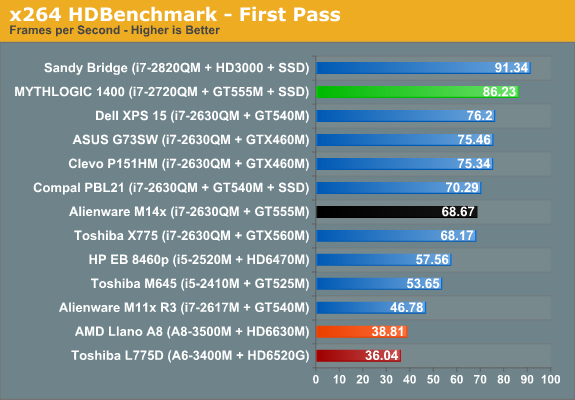

Everything falls out right where it should in our tests: the Pollux 1400 is super fast in PCMark Vantage (thanks to the combination of SSD, CPU, and GPU), and the i7-2720QM is faster than another other mobile CPU we’ve tested, with the exception of the slightly higher clocked i7-2820QM. You can also see how popular the i7-2630QM is with big OEMs; interesting to note is that for smaller companies like MYTHLOGIC, there doesn’t appear to be much of a pricing break on the 2630QM. The upgrade from the 2630QM to the 2620QM costs a scant $25, which seems like a very good deal compared to the $150 extra you’ll pay for that upgrade at Alienware.
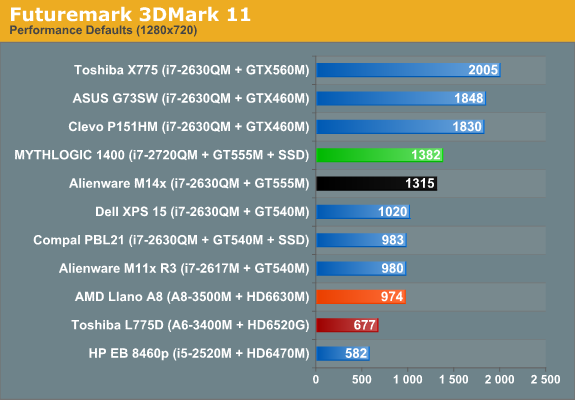
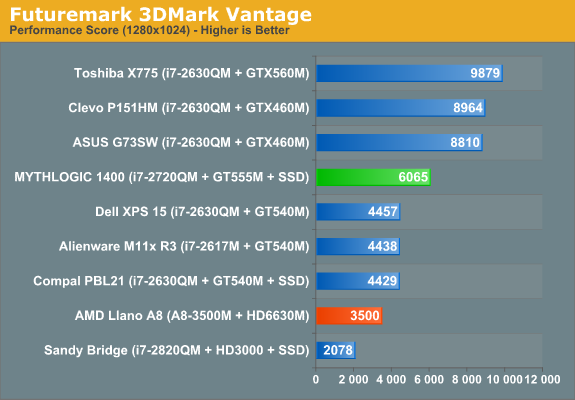
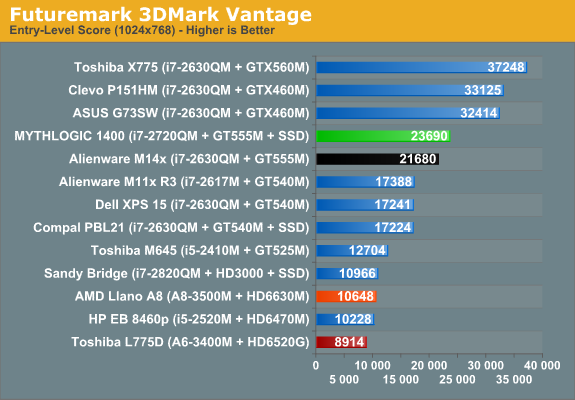
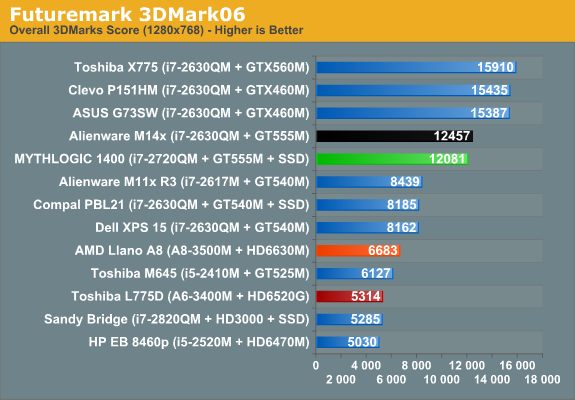
And as one final set of charts before we get to the games, here’s what the various 3DMark suites tell us. The Pollux 1400 actually bests the Alienware M14x in two of the three results where we have M14x scores, which is odd considering the 192-bit interface employed by the GT 555M in the M14x. We’ll have to see if any of that carries over into actual games, as on paper we’d expect the M14x to come out ahead for graphics benchmarks.










22 Comments
View All Comments
chinedooo - Tuesday, August 23, 2011 - link
my hp dv6t blows this thing outta the water. Its thinner lighter, and the 6770m is a better card than the gt 555bji - Tuesday, August 23, 2011 - link
The HP dv6t is several hundred dollars more expensive at a comparable configuration, and I don't know if the screen is as good as the Clevo (not saying it isn't, I just know that the Clevo screen is one of the best, and I don't know anything about the HP). So I wouldn't say it 'blows the Clevo out of the water', it's better in some areas and worse in others (like price).That being said, the Clevo sucks for many reasons (see my previous comment) so it may be that in useability the HP does blow the Clevo out of the water; I don't know as I have never used the HP.
lolthisisfunny - Tuesday, August 23, 2011 - link
Just made an account so I could tell you that you are way wrong. The dv6t has REGULAR 30% coupons that bring the price of a 6770m laptop to as little as 800 bucks.I used to have a dv6t, sold it, but for 1000 bucks with tax I got:
1080p matte screen
quad core 2630qm
amd 6770m
You won't find a better deal for raw specs anywhere else.
This mythlogic costs 1637. LOL
bji - Tuesday, August 23, 2011 - link
You are right, that is a better price. However, is the screen the same quality as the Clevo's screen?JarredWalton - Wednesday, August 24, 2011 - link
Take your dv6t price, add $250 for the 120GB Intel SSD, another $150 to upgrade the CPU from the 2630QM to the 2720QM, and an additional $120 to upgrade from the AUO B156HW01 v1 to the v4 -- both are matte, but the v4 is 95% NTSC gamut with slightly better viewing angles and better overall color.You're at $1674 for the basic setup, minus a 30% coupon (if you wait around for one to show up), and you still have to pay $250 for the Intel 120GB SSD since you can't configure it from HP that way. Or, you can take the Clevo, drop the SSD, downgrade the LCD and CPU, and you'd be looking at closer to $1200.
Basically, it's the same price minus the 30% coupon you mention, which isn't always available. As for the graphics... well, that's a whole different can of worms. 6770M is faster than GTX 540M, but against the 555M it's a toss up. NVIDIA's Optimus versus AMD's discrete graphics however ends up woefully lopsided in favor of NVIDIA, unless you don't care about battery life?
GSNorby - Tuesday, August 23, 2011 - link
Nice review on the Pollux 1400.I would point out one fundamental difference between the other Clevo customizers and MYTHLOGIC: The Phoenix Upgrade Policy is unique in my experience.
What this policy does is to assure people like me, who often agonize over component choices, that they won't be left in the cold when newer, better components come available. (In my previous experience, that happens about 26 seconds after the sale is final.) With MYTHLOGIC, you can upgrade very inexpensively, for the life of the system.
From their webpage:
----
You will be responsible for all shipping and handling charges (to and from MYTHLOGIC), plus our component cost plus 5% (limited to MYTHLOGIC approved hardware). All labor and testing is on us as part of owning a MYTHLOGIC computer.
The PHOENIX Upgrade process also includes your MYTHLOGIC computer going through the assembly, pre testing, software configuration, benchmarking and recovery disk creation quality checklists.
In addition your MYTHLOGIC computer will also receive extra pampering via interior and exterior case cleaning, software updates, driver and firmware updates and a fresh OS install topped off with a brand new Recovery Kit (At your option of course).
----
I have never seen this sort of policy offered by any other vendor. It really adds value to the system, and is the difference between investing in a system and paying over and over for the base unit when new stuff comes along.
bji - Tuesday, August 23, 2011 - link
The shell and most of the components are identical to several other Clevo models; I bought and sold a very similar Clevo W150HN laptop recently. I bought it because, like the review mentions, it is hard to get better bang-for-the-buck value than with this generation of Clevos. The cost of the entire laptop is not much more than the cost of the constituent parts, and you are getting lots of horsepower and a great display for your money.I agree that the display is just incredible (I also got the 95% color gamut matte display and agree that it is among the best laptop displays available). And the laptop itself was fairly well built.
However, that's just about all that I can say that is good about this generation of Clevos. They run a bit hot and have very annoying fan noise (although it is my understanding that the W150HR has better fan controller firmware and runs the fan quieter and less often than the ridiculous W150HN). The keyboard is TERRIBLE. I know these things are subjective but seriousy, I could not imagine a more flexy, squishy, looser and more awkward feeling keyboard than that on these Clevos. Also they have a really dumb number pad layout that is nearly useless and wastes real estate (from what I understand; I never use number pads anyway but I did find the placement of several keys that I do use like delete and page up/down annoying). The speakers are regarded as some of the worst available on any laptop. And the headphone jack, at least on my unit and running under Linux, was not able to drive my headphones more than maybe 1/2 normal volume at the highest volume setting. The touchpad has a very unpleasant feel and is so super sensitive that just having your palms above it while typing is enough to send your pointer randomly off into no man's land frustratingly often.
Make no mistake, these laptops are ALL FUNCTION, and absolutely ZERO FORM. Meaning, that if you just need raw horsepower in the most ungainly package possible, then these are a really great value. If you care at all about the experience of using the laptop, then move on. These just suck. I was so disappointed that I sold mine after 2 months at a $400 loss. I was lured by the specs and excited to receive it but my excitement quickly wore off in the face of all of the useability issues with the laptop I found myself almost never using it, because it was so unpleasant.
sablar - Tuesday, August 23, 2011 - link
I bought the MSI GE620DX which is very similar in terms of specification (555m, 144, 128-bit, 1080p) and in being kind of a budget gaming notebook.Pretty happy with it overall. Mine settles in the low 80C and isn't very loud but I got the i5-2410 instead of i7 version for a good price so that kind of explains it. GPU is clocked higher and around same temp. Also has a good screen. Bad part is the touchpad which is awful with hard-to-press buttons and poor scrolling, you can't open it without voiding warranty if adding RAM or so, Could be an option for those looking at the clevo.
JLM - Wednesday, August 24, 2011 - link
Had three criterea for a laptop. 15.6 inch FHD display. Fast graphics and a solid chassis.Bought an HP dv6t and returned it for a horrible flex on the keyboard and cheap tin-can design and material joins.
Bought an XPS15 and returned it for a whimpy graphics card.
Looked at Alienware and rejected immature design.
Finally bought a Sager (this model) from xoticPC and could NOT be happier. Fast graphics, perfect display, no flex on the keyboard, no bloat, port positioning...
As far as build, better than the HP by far, about on par with the XPS. Design is completely understated and businesslike. Pressing down on all spots of the keyboard there is no flex like the HP...
Best of all, totally understated design. This thing could belong in an office environment no problem.
I bought three years parts and labor warranty and had them put on arctic silver. I guess if it gets too hot they will have to fix it. I can play games with it on my lap. It does heat up on the left side, but doesn't burn.
Highly recommended. Check out the notebook check review as well.
bhima - Thursday, August 25, 2011 - link
I have the 540m MYTHLOGIC version of this machine and its been running strong. You can't beat that 95% gamut matte screen, I don't think I'll ever go back to a crappy base-model panel again.